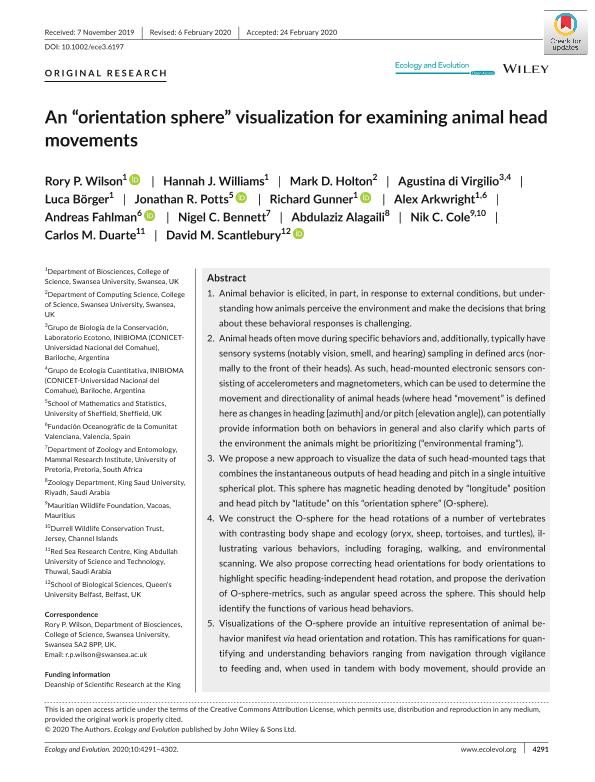Mostrar el registro sencillo del ítem
dc.contributor.author
Wilson, Rory P.

dc.contributor.author
Williams, Hannah J.

dc.contributor.author
Holton, Mark

dc.contributor.author
Di Virgilio, Agustina Soledad

dc.contributor.author
Börger, Luca
dc.contributor.author
Potts, Jonathan

dc.contributor.author
Gunner, Richard
dc.contributor.author
Arkwright, Alex
dc.contributor.author
Fahlman, Andreas
dc.contributor.author
Bennett, Nigel C.
dc.contributor.author
Alagaili, Abdulaziz
dc.contributor.author
Cole, Nik C.
dc.contributor.author
Duarte, Carlos M.
dc.contributor.author
Scantlebury, David M.
dc.date.available
2023-08-10T11:36:57Z
dc.date.issued
2020-03
dc.identifier.citation
Wilson, Rory P.; Williams, Hannah J.; Holton, Mark; Di Virgilio, Agustina Soledad; Börger, Luca; et al.; An “orientation sphere” visualization for examining animal head movements; John Wiley & Sons Ltd; Ecology and Evolution; 10; 10; 3-2020; 4291-4302
dc.identifier.issn
2045-7758
dc.identifier.uri
http://hdl.handle.net/11336/207722
dc.description.abstract
Animal behavior is elicited, in part, in response to external conditions, but understanding how animals perceive the environment and make the decisions that bring about these behavioral responses is challenging. Animal heads often move during specific behaviors and, additionally, typically have sensory systems (notably vision, smell, and hearing) sampling in defined arcs (normally to the front of their heads). As such, head-mounted electronic sensors consisting of accelerometers and magnetometers, which can be used to determine the movement and directionality of animal heads (where head “movement” is defined here as changes in heading [azimuth] and/or pitch [elevation angle]), can potentially provide information both on behaviors in general and also clarify which parts of the environment the animals might be prioritizing (“environmental framing”). We propose a new approach to visualize the data of such head-mounted tags that combines the instantaneous outputs of head heading and pitch in a single intuitive spherical plot. This sphere has magnetic heading denoted by “longitude” position and head pitch by “latitude” on this “orientation sphere” (O-sphere). We construct the O-sphere for the head rotations of a number of vertebrates with contrasting body shape and ecology (oryx, sheep, tortoises, and turtles), illustrating various behaviors, including foraging, walking, and environmental scanning. We also propose correcting head orientations for body orientations to highlight specific heading-independent head rotation, and propose the derivation of O-sphere-metrics, such as angular speed across the sphere. This should help identify the functions of various head behaviors. Visualizations of the O-sphere provide an intuitive representation of animal behavior manifest via head orientation and rotation. This has ramifications for quantifying and understanding behaviors ranging from navigation through vigilance to feeding and, when used in tandem with body movement, should provide an important link between perception of the environment and response to it in free-ranging animals.
dc.format
application/pdf
dc.language.iso
eng
dc.publisher
John Wiley & Sons Ltd

dc.rights
info:eu-repo/semantics/openAccess
dc.rights.uri
https://creativecommons.org/licenses/by-nc-sa/2.5/ar/
dc.subject
ANIMAL BEHAVIOUR
dc.subject
ENVIRONMENT FRAMING
dc.subject
HEAD MOVEMENT
dc.subject
HEAD PITCH
dc.subject
HEAD YAW
dc.subject
ORIENTATION SPHERE
dc.subject.classification
Otros Tópicos Biológicos

dc.subject.classification
Ciencias Biológicas

dc.subject.classification
CIENCIAS NATURALES Y EXACTAS

dc.title
An “orientation sphere” visualization for examining animal head movements
dc.type
info:eu-repo/semantics/article
dc.type
info:ar-repo/semantics/artículo
dc.type
info:eu-repo/semantics/publishedVersion
dc.date.updated
2021-01-27T19:53:56Z
dc.identifier.eissn
2045-7758
dc.journal.volume
10
dc.journal.number
10
dc.journal.pagination
4291-4302
dc.journal.pais
Reino Unido

dc.description.fil
Fil: Wilson, Rory P.. Swansea University. College of Sciences; Reino Unido
dc.description.fil
Fil: Williams, Hannah J.. Swansea University. College of Sciences; Reino Unido
dc.description.fil
Fil: Holton, Mark. Swansea University. College of Sciences; Reino Unido
dc.description.fil
Fil: Di Virgilio, Agustina Soledad. Consejo Nacional de Investigaciones Científicas y Técnicas. Centro Científico Tecnológico Conicet - Patagonia Norte. Instituto de Investigaciones en Biodiversidad y Medioambiente. Universidad Nacional del Comahue. Centro Regional Universidad Bariloche. Instituto de Investigaciones en Biodiversidad y Medioambiente; Argentina
dc.description.fil
Fil: Börger, Luca. Swansea University. College of Sciences; Reino Unido
dc.description.fil
Fil: Potts, Jonathan. University Of Sheffield; Reino Unido
dc.description.fil
Fil: Gunner, Richard. Swansea University. College of Sciences; Reino Unido
dc.description.fil
Fil: Arkwright, Alex. Swansea University. College of Sciences; Reino Unido
dc.description.fil
Fil: Fahlman, Andreas. 6fundación Oceanogràfic de la Comunitat Valenciana; España
dc.description.fil
Fil: Bennett, Nigel C.. University of Pretoria; Sudáfrica
dc.description.fil
Fil: Alagaili, Abdulaziz. King Saud University; Arabia Saudita
dc.description.fil
Fil: Cole, Nik C.. Durrell Wildlife Conservation Trust; Reino Unido
dc.description.fil
Fil: Duarte, Carlos M.. King Abdullah University Of Science And Technology; Arabia Saudita
dc.description.fil
Fil: Scantlebury, David M.. The Queens University of Belfast; Irlanda
dc.journal.title
Ecology and Evolution
dc.relation.alternativeid
info:eu-repo/semantics/altIdentifier/url/https://onlinelibrary.wiley.com/doi/abs/10.1002/ece3.6197
dc.relation.alternativeid
info:eu-repo/semantics/altIdentifier/doi/http://dx.doi.org/10.1002/ece3.6197
Archivos asociados
